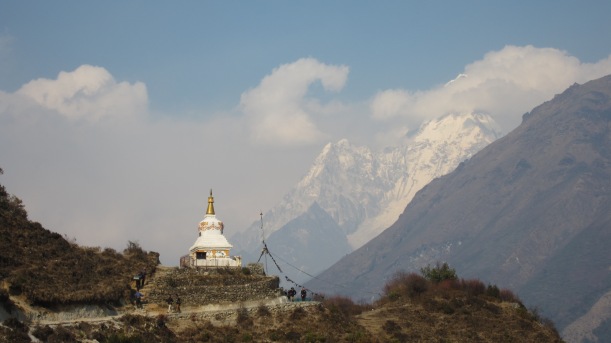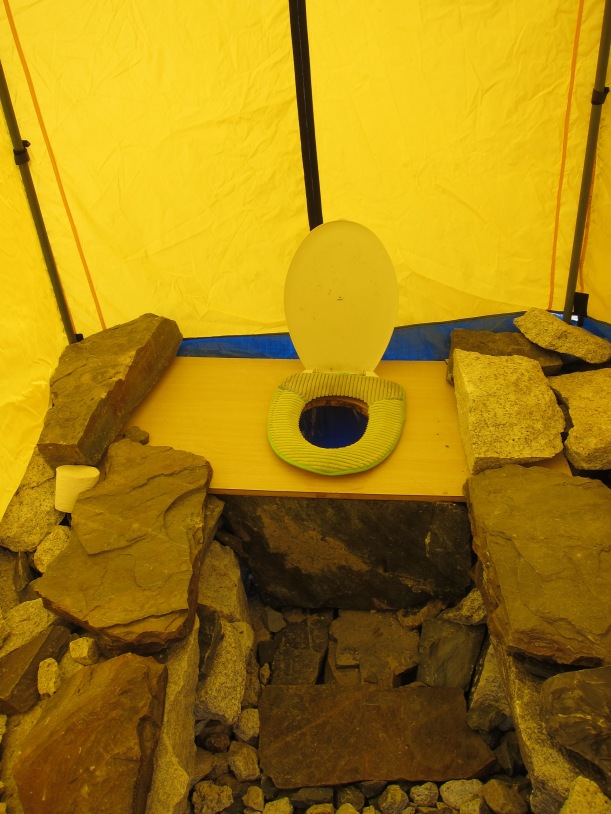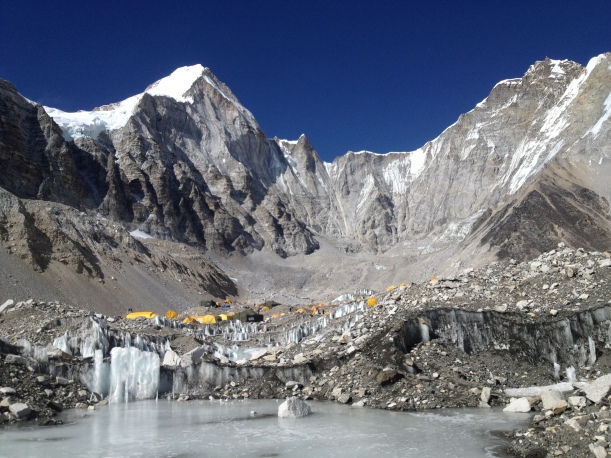Trekking is one thing; climbing mountains is quite another. I blogged about my trek to Everest Base Camp with my awe-inspiring friend Victoria Tracey and her summit expedition team. While I trekked back down they stayed high in the mountains, making their preparations and – many long weeks later – attempting to reach the summit. So what’s it like to climb Mount Everest?
Far more rugged than anything I’ve done, or can ever imagine attempting, here is the account Viki wrote of her bid to stand on top of the world’s highest mountain.
It began in the early hours of the 13th May. Breakfast at 04:00; crampons, harness and headlamps on; out into the night for our last trip up through the Icefall. Ice and rock crunch beneath our crampons, the sherpas hum and chant – praying for our safety – we breathe hard and we keep climbing. I am overwhelmed by how much the route has changed since our last trip through. Crevasses yawn deep and wide, teetering seracs loom above our heads, ladders have multiplied and are perched at ever more improbable angles throughout the route, and avalanche debris is visible seemingly everywhere. I marvel at the power of nature and hope it stays quiet as we thread our way through. It does, and we reach Camp 1. We rest.
At 06:00 on the 14th we gear up for the move to Camp 2. The journey takes us through the relatively low angled Western Cwm where the heat and sun is the biggest fear. To date we haven’t experienced that, in fact, I have had some of my coldest moments here. I put hand warmers into my mittens and we set off. It’s never warm, but the weather is benign and we reach Camp 2 without incident. We rest.
The 15th is our big move up the Lhotse Face to Camp 3. It’s steep blue ice – careful and concentrated footwork is needed – and it’s unrelenting. The last time we did this it was tough. Very tough. My stomach knots in apprehension. I say nothing and put on my crampons. The climb is hard, I am slower than last time, my hacking cough (now 40 days old) is hurting me. I get to Camp 3 and Justin puts a hand on my shoulder and asks how I am. I try to talk and breathe and not cough and not cry (Why am I so weak?) and my throat closes and I start to wheeze. I am too tired to be frightened that I cannot breathe. But Mingma and Justin are there and an O2 mask is pushed on my face and I can breathe again. I move impossibly slowly up to the tent 20ft away. (Where is the girl that everyone always laughs at for walking so quickly?!). But the oxygen is magic. I feel better and better and eat and eat. My tentmate arrives and we commiserate and hug; “Isn’t this meant to get f***ing easier”?! Sometime later Peter is there. He checks my O2 saturation… 90%. At sea level I would be intubated, at Camp 3 it’s outstanding. We smile at each other. My climb will not end today. We rest.
The 16th begins hours before dawn. The move to Camp 4 (the South Col) is huge. It’s our first time climbing on oxygen and I am nervous about whether my goggles will fog and how hard it will be to climb when I can’t see my feet. In the final analysis it’s much less bad than I feared and today is wonderful. I climb to the top of the Lhotse Face, traverse over to, and surmount, the Yellow Band and head for the steep Geneva Spur. My feet follow the path beaten by my climbing heroes and I can’t believe I am here. It is hard work, impossibly hard work, but I feel amazing. I see Adrian, my Guide from Ama Dablam and we hug and share a joke. This place is amazing. I pull over the top of the Geneva Spur and realize we have a long rocky traverse to get to the South Col. It seems to take hours to complete, but finally I am there; the South Col… arguably the highest campsite in the world. It’s barren rock… I could be on the moon… the wind is howling… tents bend at improbable angles in the wind, their flies torn and flapping… debris is everywhere. I am tired now. Incredibly tired. But I look up. For the first time, I can see the route to the summit of Everest. I have a picture of this view pinned above my desk at work and now I can see it with my own eyes. I am impossibly proud of myself for getting here. But there is no time for that, Phunuru urges me toward a tent. It’s about noon and if we are going to leave for the summit I will need to start getting ready at 7pm for a 9pm departure. I have expended thousands of calories in energy and injested very few and need to work to try to address that.
Time passes and Justin is in the tent. The winds are set to drop later and if that happens we will go, if not, we may spend an extra 24 hours at the Col. This is a daunting prospect, even on oxygen we will weaken here. Our fragile bodies are not meant to be at 26,000ft. But I am not worried as we have this conversation in the tent which is bent almost double in the wind. My friends are with me. Justin and Peter are here and Greg is at EBC and whatever will be, will be. Justin will bring us the final decision in a few hours so my tentmate and I settle in. We pretend to rest.
It’s a GO! The wind is howling, there is not a star in the sky and I am at 26,000ft about to head 3,000ft up. But I am calm. My mind is clear and I think about risk. Mingma comes to help me change oxygen bottles. There is hissing, the regulator isn’t sitting right and oxygen is being released. But I am calm. I look at Peter, we’ve talked about this, “We need hot water”, I say. “We need hot water” he agrees. Phunuru disappears and then returns with a new regulator. I feel a flicker of apprehension, but the new regulator makes a solid seal. With Mingma’s help, I shoulder my pack and turn into the wind.
Almost immediately we are heading up a slope of blue ice. I concentrate hard on making good steps and not slipping. The wind seems to be picking up and snow and ice start to blow in hard from the left. I refuse to be distracted and the ice eventually gives way to a steep snowy slope; the Triangular Face. We keep moving. The wind keeps howling and the snow keeps blowing. I am covered in rime ice; a thick layer forms on my down suit, my jumar (which keeps me from sliding back down the safety rope should I fall) and on my clear goggles. As the ice on my goggles builds, my field of vision decreases (next time you’re on a flight in a storm, look at the windows… that icy covering is exactly what, and all, I could see). Part of my brain cackles with laughter; ‘You’re approaching 27,000ft and you cannot see a bloody thing!’. The vaguely lucid, not maniacal, part of my brain just implores me to be cautious. The route steepens and snow starts to be interspersed with rocky steps that require careful navigation. The wind keeps howling and the snow keeps blowing. The rime ice is now thick on the fixed line and my jumar (which should only slide upwards and so stop me falling down the mountain) is no longer gripping the rope. (The teeth which bite the rope are full of ice so the device can now slide bi-directionally, effectively rendering it useless). “Better not fall”, I think to myself and grab hold of the rope with my other hand. We keep moving and the wind keeps howling. I do an extremity check (wiggle fingers and toes) and all is well. Justin and I had talked extensively on how to keep hands and feet warm a world away in Ouray earlier this year. That plan is working well and I allow myself a small moment to feel pleased with myself. It’s very brief. My vision issues are now further hindered by the fact that my headlamp is almost out of juice. The new batteries that I had dutifully put in a few hours ago are being sapped by the cold. I have spare batteries tucked into the chest pocket of my down suit but they may as well be on Mars… it’s infeasible that I could stop, take off mittens and change the batteries. But I do slide one hand out of a mitten and scratch at the surface of the goggles. Mercifully the ice is all on the outside and I can sort of see again. Joy! I quickly thrust my hand back in my mitten and wiggle everything frantically. The chemical handwarmer in there is doing its job valiantly and everything feels good. I allow myself a(nother) small moment to feel pleased with myself. But now headlamps are turning and descending towards me. The wind is not dropping and the snow is not stopping and people are turning back. We keep moving. Then, as he always is, Justin is there. He’s just been up to the Balcony a couple of minutes above us (~27,600ft) where the wind is gusting to 50mph. “It’s time to turn around VT”, he says. I can see his eyes. He looks utterly bereft to be ending our team’s summit dreams. I feel nothing.
We turn and start down. The wind keeps howling and the snow keeps blowing. It’s steep and treacherous and suddenly all I can think about is how much my body hurts, how terrifying descent is and how incredibly, mind bogglingly far away the South Col is. My eyes fill with tears, “Oh my God VT do not lose your sh*t now”, I think to myself. Mingma must sense my anguish and puts his hand on my shoulder. He stays behind me and Justin stays in front of me for what seems like the eternity it takes to make our way back to the South Col. As we return, the sun is starting to rise. The lifting of the darkness brings no joy. We are hours of climbing away from real safety. I clamber into the tent.
Sometime later Justin is in our tent. There is an (unexpected) option to try again for the summit tonight. I know in my heart that I haven’t got enough to get to the top and back down again safely. I promised myself before the trip that nothing is worth risking my life (or someone else’s life) for. I am done. I look miserably at Justin, wishing more than I have ever wished for anything before it was different. He agrees with me. I am utterly, utterly, utterly ashamed. I have failed. I am so physically and emotionally destroyed I can’t even cry, I just sag in the sleeping bag. My tentmate concludes it’s the end of the road for her as well and discussion turns to descent. We need to leave at noon… about 3 hours hence… and descend the 5000 treacherous feet to Camp 2. This is not a surprise. But the reality is horrifying. I have never been so tired in my life.
It is noon. It is time. Peter goes with our small band, Justin stays with our other two members who are still debating if they will go up. We head out into the wind and start the long journey down. “I don’t think I can do it”, I say to Peter, my eyes swimming with tears. “You must”, he responds implacably, all trace of the gentle, joking friend of the last two months gone. He is right. I must. So I do.
+++++++++++++++
4 days later, stranded in Lukla (I clearly offended the weather gods in a previous life), my heart feels broken. I have dreamt about standing on the highest point on the planet for years… even when I was feckless, dissolute and 235lbs it was something I wished for… and I have failed to do it.
My heart is broken.
But I am not.
My fingers and toes are grubby but utterly unharmed. My hacking cough (and cracked ribs?) will heal. And the 20lbs I’ve lost will (undoubtedly) come back with a vengeance. I am alive.
For this, and for all the joys of this amazing, awful, incredible experience, my debts are enormous…
… to Mingma; who was always there, just ahead, or just behind, me keeping safe. Patience personified.
… to Justin and Peter; who always were there for all of us. Unflappable and inspiring of confidence even when everything felt like it was going to hell in a handbasket.
… to Angela; for her friendship and kindness under the most extreme duress; the complete antithesis of the selfish ‘every man for himself’ mountaineer. I owe you six Fruity Snacks and my sanity.
… to my family; who have helped forge in me the strength of will that I needed to keep my promise not to kill myself or anyone else. And who make me want to come home even when it’s agony to do so.My heart is broken.
But I am not.
Thanks for joining me on this wild ride.






























